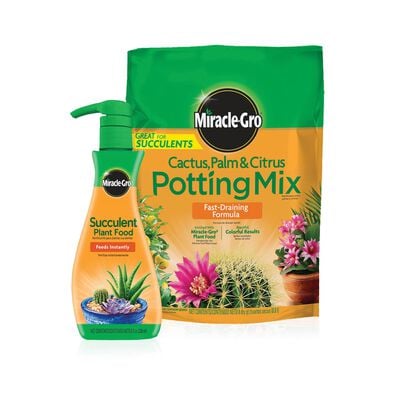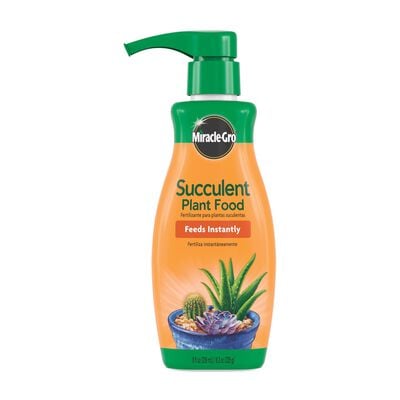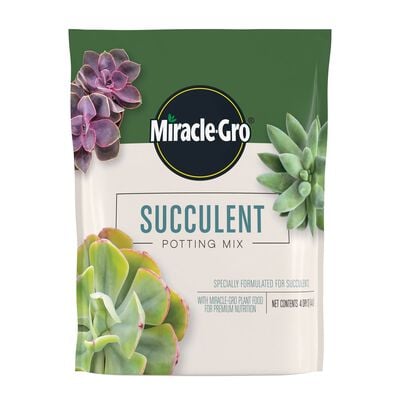
How to Grow a Christmas Cactus
Looking for a plant that will bloom while others sleep? You've come to the right place.

- Grow in indirect light.
- Plant your Christmas cactus in Miracle-Gro® Cactus, Palm & Citrus Potting Mix.
- Water when the top 1 to 2 inches of soil are dry.
- Increase humidity around the plant.
- Feed from after blooming until fall with Miracle-Gro® Succulent Plant Food.
- Give your Christmas cactus 6 weeks of extra darkness and lower temps to encourage blooming.
- Prune after blooming for the best shape.
- If desired, root the stem sections you pruned off the plant to create more Christmas cacti.
Christmas cacti are a cinch to find in just about any garden center or grocery store starting in fall and continuing through until early spring. These easy-to-grow houseplants bloom while everything else is taking a break, so they're great for adding a bit of color inside during the winter. Many of the plants you'll see labeled "Christmas cactus" at the store are actually Thanksgiving cacti, which tend to bloom a little earlier. Don't worry, though—you care for both the same way.
These cacti (all part of genus Schlumbergera) are native to the coastal mountains of southeast Brazil, and naturally grow among the tree branches or in cracks in the rocks at high elevations (2000 feet or more). These free-draining, shady, somewhat moist conditions of their original homes are a far cry from the deserts where we often think of cacti growing! That's important to know because you'll want to care for a Christmas cactus differently than you would other kinds of cacti.
Here's what to do.
Where to Grow a Christmas Cactus
Given its home climate, it won't surprise you that Christmas cacti thrive in indirect light and humid conditions. Growing your Christmas cactus in a north- or east-facing window is ideal, but wherever you end up putting it, make sure to keep it out of direct sunlight. If you see the leaf-like pads turning red, that's a huge hint that they're getting too much light.
You can actually move Christmas cacti outside during the summer—they'll love the humidity! Just be sure to keep them in a protected, shady area (you could even hang them among the tree branches for a landscape surprise) and don't let pots sit in water after a heavy rain.

How to Plant a Christmas Cactus
Christmas cacti grow best—and usually produce more flowers—when they’re snug in their containers. When the roots have pretty much filled the pot, though, follow these steps:
1. Select a new pot that is just 1 to 2 inches wider than the current one and has a drainage hole.
2. Fill the new container ⅓ full with Miracle-Gro® Cactus, Palm & Citrus Potting Mix, which provides excellent drainage and a little bit of food to help your Christmas cactus thrive right off the bat.
3. Place the plant in the container and check to make sure the top of the root ball is about ¾ to 1 inch below the top of the container.
4. Fill in around the rootball, leaving about ¾ inch of empty space (for easy watering) between the top of the soil and the lip of the container.
5. Thoroughly water the plant, let it drain, and move it to its long-term home. (Set a waterproof saucer underneath the pot so it won’t leak all over the furniture.)
Insider tip: The best time to repot is in late spring once plants have recovered from blooming and started to grow again.
How to Water a Christmas Cactus
Remember, Christmas cactus plants like soil that consistently has more moisture than the soil preferred by most other succulents. In general, water a Christmas cactus when the top inch or 2 of soil is dry. To help increase the humidity around your plant, fill the pot saucer with pebbles and add water to just below the tops of the pebbles (the pot shouldn’t be sitting directly in water). The air will become more humid as the water evaporates. (For tips on watering when you’re trying to encourage your Christmas cactus to rebloom, see below.)
How to Feed a Christmas Cactus
In order to give you those gorgeous blooms for the holidays, Christmas cacti need to have regular, nutritious meals from the time they finish blooming all the way into fall—that’s how they store up enough energy to produce the next round of flowers. Here’s what to put on the menu: Miracle-Gro® Succulent Plant Food, which is specially designed to give cacti and other succulent plants just the right kind and amount of nutrition. Use 2 pumps for small pots and 5 pumps for larger pots (over 6" diameter), and be sure to follow the directions on the label.
How to get a Christmas Cactus to Bloom
To get a Christmas cactus to bloom, you need to give it 6 weeks of “short days” (meaning 13 to 16 hours of total darkness) and low temperatures. Here’s an easy way to do this: In the fall, move your plant near a window (but out of direct light) in a cool room (55 to 60 degrees F) that doesn’t get used at night. Keep the door shut and the lights off, stop feeding, and cut back on watering. After 6 weeks, bring the temperature in the room up to 65 degrees F and allow the plant a little more light. As soon as you see flower buds starting to form at the ends of the stems, move your Christmas cactus where it belongs: center stage for the holidays!
How to Prune a Christmas Cactus
When given the kind of TLC we’ve been talking about, Christmas cacti can live for decades. To keep yours full and bushy, you’ll want to prune it once it finishes blooming. Don’t worry—it’s a really simple process. Just remove 2 or 3 stem sections per branch on about half the plant by giving the stem a quick twist between segments. (You can prune the other stems next year.) If branches start breaking off because the plant is so large, trim it a little more. That’s it!
How to Grow More Christmas Cacti
Instead of tossing those pruned sections into the compost, why not root them to make more lovely Christmas cacti for your friends? Dip each cutting into a rooting hormone and stick it into barely moist potting mix. (You can root several cuttings in a single container—just make sure it has drainage.) Let the cuttings sit for a few weeks, keeping the potting mix just slightly moist, and then check to see if they have roots. Once they do, you can water them a bit more. As they grow, move your new Christmas cactus babies into their own pots.
How to Deal with Christmas Cactus Problems
These plants are pretty easy to grow, but they do have some common issues worth knowing about.
- Blooms drop off before opening. The culprit here is usually a sudden change in light, drafts of cold or hot air, or large swings in moisture level. Move the plant if it’s in a draft, even out your watering, and if you recently moved the plant into more (or less) light, try leaving it alone for a while to recover.
- Leaf-like pads are red. This means the plant is getting too much light, so move it to a new spot or farther away from the window.
- Areas of the plant have turned black and slimy. If this happens, it’s likely that your Christmas cactus has a fungal or bacterial disease. Unfortunately, the best course of action usually is to throw out the plant and start over.
- Base of the plant looks woody or corky. This is normal and simply means that you’ve had the plant long enough for it to begin aging—and that’s a wonderful thing. Congratulations!


